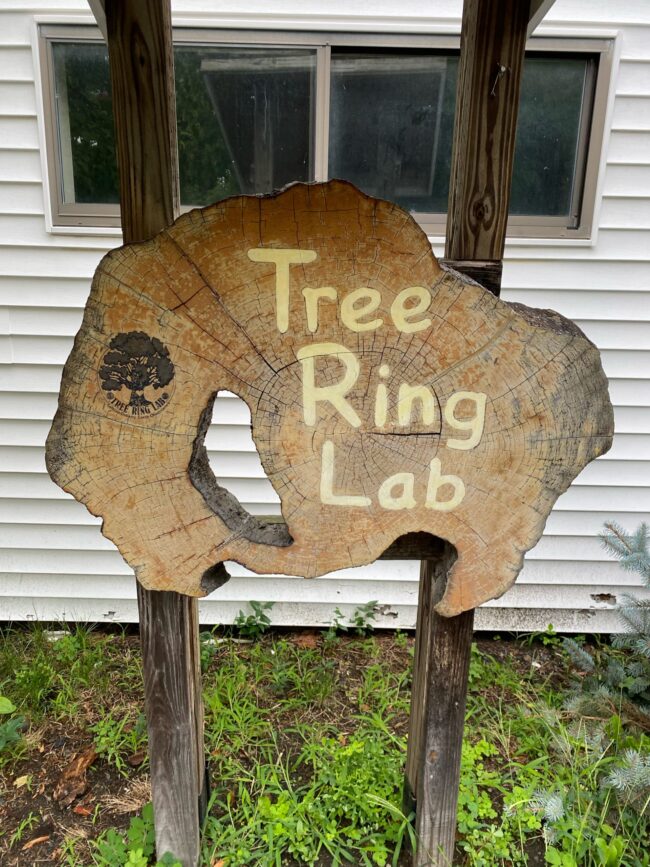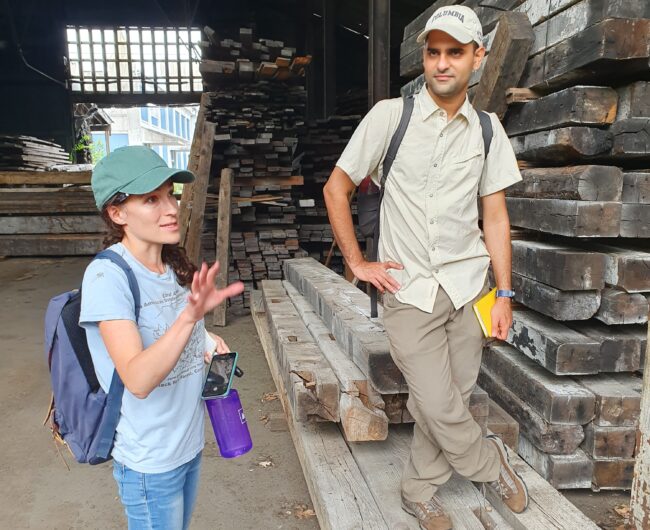One recent morning, Alan Solomon, owner of Sawkill Lumber, reached out to Mukund Rao, a dendrochronologist—a scientist who studies tree rings. The subject: old timber beams at a demolition site in New York City. If they moved quickly, they could intercede before the beams were carted off to a landfill.
Why would old timbers be of great interest to both Solomon and Rao? A lumber-company owner and a scientist might seem like an unlikely duo, but they are united by a passion for preserving historical record: Solomon through refurbished floorboards and furniture; and Rao, an assistant research professor at the Lamont-Doherty Earth Observatory, as time capsules that indicate past climate conditions and details about centuries-old human history. Both Solomon and Rao are members of Save the Timbers—a group dedicated to rescuing old timber, some of it dating back millennia, that would otherwise be discarded and forgotten.

After collecting samples from the timber at the demolition site, Rao brings them to his office at the Tree Ring Laboratory at the Lamont campus in Palisades, New York. (Lamont is part of the Columbia Climate School.) There, scientists will analyze the samples, racing against time to uncover the secrets of old-growth trees before they’re lost forever.
“Timber regenerates, but old-growth forests take a long time to develop,” says Caroline Leland, a fellow dendrochronologist at the lab. “And each one contains centuries of environmental data. It’s scary because once we throw them away, there’s no going back.”
With estimates ranging from under 10 percent to around 18 percent of old-growth forest remaining in the U.S., we’ve lost a significant portion of these ancient ecosystems—making their vulnerability to fire, pests, disease and logging even more alarming.
Decoding History in the Tree Ring Lab
This year marks the 50th anniversary of the Tree Ring Lab, established by Ed Cook and Gordon Jacoby with a grant from the National Science Foundation in 1975. Back then, tree ring research was a young field, evolving from simply dating wood to tracking droughts and temperature swings. The Lamont Tree Ring Lab—among the first in the world—would expand dendrochronology’s capabilities over the years and become a global leader in research, training and technology.
The inside of the Tree Ring Lab is comfortable and academic, with carpeted floors and kitchenette. Its A-frame ceiling is lined with red metal beams and machinery—remnants of the building’s past use for making oceanographic equipment before it was converted for studying tree rings.

Once samples are collected, Rao and Leland examine the tree rings under a microscope and use high-resolution scanning to measure the widths of each ring. These details reveal how wet, dry, hot or cold the climate was when the tree was alive, helping scientists understand conditions from hundreds of years ago.
After gathering data from multiple tree samples at a site, scientists compare it with other chronologies—timelines of tree-ring data from different regions—often stored in online databases or shared by colleagues. By doing this, they can create long-term reconstructions, essentially piecing together a historical record of climate changes like temperature and drought over hundreds or even thousands of years, depending on the tree’s age. The data can then be used to train climate models, allowing researchers to better predict future environmental conditions.
The Tree Ring Lab researchers have reconstructed climate patterns spanning more than a millennium in regions across the globe, shedding light on phenomena such as megadroughts in the American West and unprecedented warming in Central Asia.
Dendrochronologists have long used tree-ring data to uncover evidence of extreme climatic events, including global cooling triggered by volcanic eruptions like Mount Tambora in 1815 that triggered the “Year Without a Summer” in 1816. They’ve also traced the origins of historical artifacts, including an 18th-century ship found beneath the World Trade Center site, which came from an old-growth forest in the Philadelphia area.

Mapping New York’s Construction Boom
One of Leland and Rao’s most significant and popular studies involved the Terminal Warehouse in the Chelsea neighborhood of New York City. Originally constructed in 1891, this massive structure once served as an essential commercial hub with rail lines running directly through the building to its Hudson River pier. From 1986 to 2001, the building played host to the infamous Tunnel nightclub, the train tracks carving out an area that became the main dance floor.
During the peak of a major renovation in 2018, Leland and Rao had the opportunity to sample longleaf pine from reclaimed beams and trace the origins of the timber. Their analysis revealed new insights: the tree-ring patterns closely matched records from the Southeastern U.S., indicating that the timber had been harvested there and transported hundreds of miles to NYC.

This work, along with their other research conducted across urban edifices in NYC in the last decade, helps document the history of iconic buildings and maps the extensive timber trade networks that facilitated New York’s rapid growth during the Gilded Age.
The city’s construction boom depleted nearby forests in the early 1800s, forcing builders to seek timber from increasingly distant sources. By the mid-to-late 1800s, New York was already importing longleaf pine from as far south as Georgia and the Carolinas. “One timber from the warehouse had rings from as early as 1512,” Rao says. That same species, longleaf pine, was so prized for its strength and resistance to rot that it was exported around the world, turning up in historic buildings in the Low Countries (northwestern Europe) and as the material of a 19th-century shipwreck off the coast of Argentina.
Demolition Waste and Its Environmental Impact
Though NYC is known as a metropolis of skyscrapers, in reality, fewer than 2 percent of the city’s buildings stand over seven stories tall. More than 95 percent of structures are thought to be made from wood-frame masonry and wood construction, making the urban landscape a vast repository of forest history. And these buildings are continuously being demolished to make way for new ones.
While not every building may be built from old-growth wood, hundreds of demolition permits are issued every year across the five boroughs, with hundreds of construction permits for new buildings subsequently being distributed, according to NYC’s OpenData platform.
“New York has virtually no rules around preservation versus demolition. Unless a building has historic landmark status, it can be torn down without question,” says Rao. “Buildings come down all over the city, and few are thinking about what’s inside or what has been thrown out.”
According to the Environmental Protection Agency, building construction debris accounts for one-third of the waste generated in the United States. Between 1970 and 2000 alone, 6.3 million older and historic housing units were lost—some to fire or natural disaster, but many were demolished to make way for new development or left to deteriorate beyond repair. That’s more than 500 units a day, every day, for decades. If even half of those buildings had been preserved, enormous quantities of high-quality materials could have been diverted from landfills.
Tearing down old buildings also releases the stored carbon in timber. If wood ends up in landfills, it decomposes anaerobically and emits methane—a greenhouse gas 28 times more potent than carbon dioxide. At a time when NYC has committed to reducing building emissions by 40 percent by 2030 and 80 percent by 2050 under Local Law 97, ignoring these emissions undermines these efforts.
NYC’s Underground Circular Lumber Economy
Despite growing climate awareness among New Yorkers and policymakers, the city still lacks a comprehensive circular economy model to recover and reuse materials from demolished buildings. But some local innovators are filling the gap. Brooklyn-based companies like Sawkill Lumber, Tri-Lox, RE-CO BKLYN and Bien Hecho reclaim wood from buildings slated for demolition or from downed urban trees, transforming overlooked materials into furniture, architectural features and even museum-quality installations.
Sawkill Lumber’s warehouse in Crown Heights, Brooklyn always smells of resin and aged pine. The wood is sent to a mill in Connecticut, where workers spend their days carefully de-nailing enormous floor joists and timbers, and take them through an extensive re-manufacturing process. Inventory is organized by species, source and size. Some beams measure 12 inches wide and stretch over 24 feet long, representing longleaf pine, Eastern white pine or a rare bald cypress tree (Taxodium distichum) that used to dominate swamps and wetlands across the southeastern U.S. in the early 1600s.

“This is material you simply cannot find in a forest anymore,” says Solomon, who founded Sawkill Lumber in 2007. Solomon started the company with a mission: to rescue and repurpose rare old-growth timber from NYC before it vanishes into dumpsters and debris piles. “The durability, provenance and beauty of this wood is unmatched by anything available today.”
These antique beams will be reborn as flooring, tables and furniture, or architectural details in a range of residential and commercial projects across New York City and beyond—usually fetching higher prices than newly milled lumber. Still, the economics of salvage are far from easy.
“We increasingly have to bid for the material that is handled by demolition companies. They’d otherwise pay to dispose of it, but still need further incentive,” Solomon says. “But the labor costs are substantial, and we can only salvage a fraction of what’s available.”
Just down the road at Bien Hecho in the Brooklyn Navy Yard, the team is reincorporating reclaimed wood into the very buildings it came from. In one recent project, the team partnered with Worrell Yeung Architects to salvage hundreds of feet of original heart pine beams from a six-story 1920s factory near the yard. That same wood now greets visitors in the form of a custom-built conference table and bench, returned to the site as heirlooms.
Still, without standardized processes to divert reusable materials—or incentives for developers to deconstruct rather than demolish, high-value timber continues to be sent to landfills. Deconstruction takes more time and labor, which often makes it financially unappealing in New York’s fast-moving real estate market.
A Vision for a Circular Future
Other cities offer compelling models. Portland, Oregon, passed a deconstruction ordinance in 2016 requiring manual dismantling, rather than mechanical demolition, for homes built before 1940. A study from Oregon’s Department of Environmental Quality found that each deconstructed home saves roughly 7.6 metric tons of CO2e and can yield on average 6,000 board feet of reusable lumber. That same house, if demolished, generates 127 tons of debris. Inspired by Portland, cities like Seattle and San Antonio have launched their own programs.

“If New York implemented similar requirements for buildings over 80 years old, we could divert thousands of tons from landfills while preserving irreplaceable materials,” says Solomon.
By teaming up with salvage companies like Sawkill, researchers like Leland and Rao are building a quiet but effective bridge between science and salvage—ensuring that irreplaceable wood and the data it holds don’t go to waste.
A local advocacy group called RECLAIM NYC is pressing for policies to promote tools and initiatives that generate demand, facilitate supply and connect salvaged goods with reuse opportunities.
“The demolition companies are actually happy when we reach out to them,” says Rao. “Otherwise, they have to pay another contractor to take away the timber. It’s better for them if we can coordinate with salvage operations.”
RECLAIM NYC’s vision is bold but practical. They propose leveraging existing platforms and marketplaces to share details on available material—such as photos, quantities and timelines—before deconstruction occurs. To support broader reach, they also recommend that NYC invest in regional storage and transportation infrastructure to create buffer time and improve the logistics of connecting supply with demand.
The stakes continue to grow. In April 2025, federal protections were rolled back on nearly 60 percent of U.S. national forests, opening more than 112 million acres to logging, citing the risk of wildfires, pests and diseases. As timber production rises, reusing what’s already been cut is more pressing than ever, especially for dendrochronologists who rely on these old-growth forests for data.
“Next time you pass a demolition site in New York,” says Leland, “take a moment to look at the exposed beams. They’re not just scraps of old construction—in some cases, they’re the last living traces of forests that predate European settlement. The question is whether we’ll see their value before it’s too late.”


